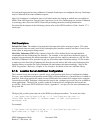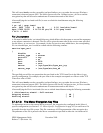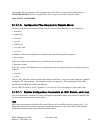Range End. If this field is zero, Port Range End field must also be zero.
Port Range End. Used in conjunction with Port Range Start (See above). Valid values are zero or any
TCP port number to which the Mover may bind (that is greater than or equal to the value of Port Range
Start). The default value is 0. If non-zero, this field must be equal or greater than Port Range Start. If
this field is zero, Port Range Start field must also be zero.
5.1.3.1. Additional Mover Configuration
The part of the Mover that handles accessing configuration metadata and servicing the Mover
administrative interface runs on the core server platform , while the part of the Mover (with which the
PVL and Core Servers communicate) that manages the storage devices and performs data transfers runs
on a remote node. To support this mode of operation, there is some additional configuration which must
be done on the remote node.
This additional configuration may be performed using mkhpss. See Section 5.1.3.1.1: Setting Up Remote
Movers with mkhpss on page 108.
Alternately, the configuration may be performed manually using the instructions from these sections:
• 5.1.3.1.1: /etc/services, /etc/inetd.conf, and /etc/xinetd.d on page 104.
• 5.1.3.1.2: The Mover Encryption Key Files on page 105.
• 5.1.3.1.3: /var/hpss/etc Files Required for Remote Mover on page 106.
• 5.1.3.1.1: System Configuration Parameters on IRIX, Solaris, and Linux on page 106.
5.1.3.1.1. /etc/services, /etc/inetd.conf, and /etc/xinetd.d
To invoke the remote part of the Mover, inetd on the remote node is utilized to start the parent process
when a connection is made to a port based on the Mover’s type specific configuration (see Section 5.1.3:
Mover Specific Configuration on page 102).
An entry must be added to the /etc/services file so that inetd will listen on the port to which the Mover
client process will connect. The port number is one greater than that configured for the “TCP Listen
Port” in the Mover’s type specific configuration. For example, if the configured listen port is 5001, the
following line must be added to /etc/services:
hpss_mvr1 5002/tcp
For non-Linux systems
An entry must be added to the /etc/inetd.conf file which defines which executable to run and the
arguments to use when a connection is detected. The entry must use the service name specified for the
Mover in /etc/services. The sole argument (other than the program name) is the pathname to a file that
contains an ASCII representation of the configured encryption key for the Mover (see the next section for
further details). For example, for the /etc/services entry added above, the corresponding /etc/inetd.conf
entry would be:
hpss_mvr1 stream tcp nowait root /opt/hpss/bin/hpss_mvr_tcp
hpss_mvr_tcp /var/hpss/etc/mvr_ek
HPSS Management Guide November 2009
Release 7.3 (Revision 1.0) 104


















